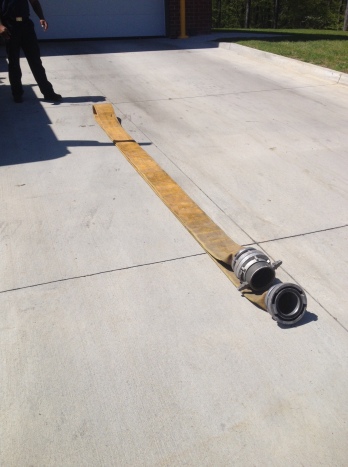This is just a simple trick that was taught to me and I have been passing on for years. Every engine company carries short supply hose sections of various sizes and lengths. I often found that when these rolls get above about 25 feet they can become a little difficult to deal with. Storage, deployment, etc. they are just difficult. A lot of these rolls are simply straight rolled, or doughnut rolled and placed in the compartment, or tray and not thought of until the next fire. Getting a water supply established is one of the most important things to do at a fire scene so making it more efficient for the driver who is usually operating alone should be just as important.
By simply rolling the hose a different way we can reduce the foot print of the hose roll, make it easier to handle, and make the deployment of it easier.
You start with the hose laid out as you normally would, and make sure it is drained.
You then take the hose over top of itself placing both the couplings at the same end.
Start rolling!
Your end result should look something like this. As you can see the foot print of the hose roll itself either upright or on its side is literally cut in half. It also gives you the advantage of exposing both couplings. Additionally it ensures that any residual water is no longer in the hose, any residual air is no longer in the hose, and makes handling it a lot easier.
When it comes to deployment, this roll almost wants to unroll itself! If in a tray or compartment you can simply grab both couplings and walk. If you choose you can still do the bowling ball roll, or connect either to the piston intake valve or large water intake on your engine then walk to the hydrant or vice versa. You can also hand ne coupling to another firefighter and then you both walk in opposite directions.
Simply put the only way you can unroll the single doughnut is to unroll it yourself, trying to bowling ball a 50 foot section of 5 or 4 inch hose is inefficient at best, and nearly impossible for some firefighters.
The best part about it is that it is a simple and basic change that you learned in your firefighter 1 class! This one little change can make a huge impact in your pump operator efficiency.
What other tips and tricks are you using in your department? Send them to averagejakeff@gmail.com and I will feature them on the site. Do not forget to keep following along on twitter @averagejakeff and as always the comments section is open for business for discussion and thoughts.
As usual thanks for reading, spread the word, and STAY SAFE!
Views: 1370
Comment
© 2025 Created by fireeng.
Powered by
![]()





You need to be a member of Fire Engineering Training Community to add comments!
Join Fire Engineering Training Community